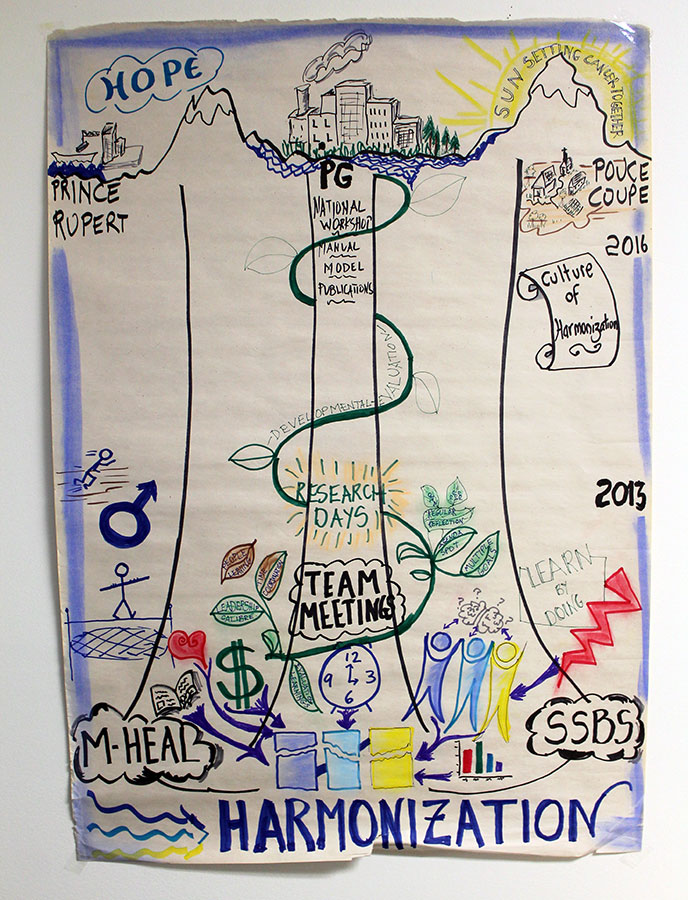Sustainability
Understanding and Achieving Sustainability
Sustainability can mean different things to different people, and the interpretation can shift over time. Collaborative projects may be focused on a singular objective or goals that create long term partnerships. Project goals and partner expectations will determine the potential for sustainability.
(banner photo:Workplaces that partnered with the Men’s Healthy Eating and Active Living team to offer the POWERPLAY program continued to make fruit available to their employees.)
What Lives On?
A completed bridge leaves a legacy that is visible and useful to the people in the region. Similarly, collaborative partnerships leave a legacy in relation to population health or project outcomes, and collaborative capacity. Sustainability will also be determined by how the partners choose to cross new bridges together in the future to achieve shared goals.
Stories and Sharing
I’ve learned that senior management support of a project is critical to sustainability. They need to not only be in-line with the vision and aims, but also approve the financial and human resources involved. Reflecting back, ideally a project should fall directly within an organizational mandate or policy for optimum sustainability.
Defining Sustainability
Collaborative sustainability can be categorized in three ways.


Try to think about what your work will look like a year after project completion. Are there continuing or new areas for partnership work? Will there still be a need for funding? Will partners still be meeting regularly? These are the kinds of questions partners need to think about when determining sustainability.
Planning for Sustainability
Discussing sustainability throughout a collaborative project will provide team members an opportunity to plan for the future and consider implications for roles and responsibilities. Deciding whether sustainability of a project or partnership is appropriate or necessary is a key to clarifying future organizational commitments and allocation of resources. It is important for all team members to be as open as possible about future plans in order to maintain amicable relationships should the partnership end. Attention should be paid to the following strategies that support sustainability.
Develop a
long-term vision
Developing a long-term vision for the collaboration can support sustainability by providing clarity of goals, expectations, and time commitments.
Foster committment
and ownership
Teams can enhance commitment to project goals and to the partnerships by providing opportunities for meaningful engagement in decision making and collaborative activities.
Aim for adaptability
and flexibility
Collaborations can support sustainability by expecting change and being open to new structures, revised plans, fluctuating team composition, and so on.
Demonstrate value
or relevance
Partners can strengthen commitment and project ownership during the life of the project by celebrating achievements and the accomplishment of short-term goals. Demonstrating value or relevance is important for ongoing support of collaborative efforts.
Stories and Sharing
Through this project we’ve been able to create a certain level of trust. I think that will be of huge value going forward and is certainly something that will nurture future relationships.
Stories and Sharing
Collaborating on the Harmonization Project has been meaningful, both from an individual learning perspective and from an organizational achievement perspective. Together we’ve been able to do what was beyond each of us alone.
Nursing students Jamie Armes and Cassie Dussault are shown here at the SSBS display table at the University Hospital of Northern BC.
Other Strategies for Sustainability
The following are evidence-based strategies that have been successfully used by other groups to sustain collaborative efforts:
Click on the tabs to view these strategies…..
Policy or organizational changes
Project work can be sustained through policy changes that support ongoing efforts, or through the institutionalization of a practice or activities within an organization.
Developing permanent advisory committees
Committees can be formed to monitor the ongoing impact of a program and to inform decision makers about the best courses of action to maintain program benefits.
Securing sustainable funding
The sustainability of collaborative projects are often dependent on continued funding and resources. Consequently, needs for ongoing financial support and in-kind contributions (e.g., staff time) for the project must be determined. Evaluation results may be critical for future funding applications and obtaining organizational commitments.
Partnership expansion
The sustainability of a collaborative project can be enhanced by building linkages with other organizations and stakeholder groups that support ongoing goals. This will extend the reach and visibility of the work.
Other Strategies for Sustainability
The following are evidence-based strategies that have been successfully used by other groups to sustain collaborative efforts:
Click on the tabs to view these strategies…..
Policy or organizational changes
Project work can be sustained through policy changes that support ongoing efforts, or through the institutionalization of a practice or activities within an organization.
Developing permanent advisory committees
Committees can be formed to monitor the ongoing impact of a program and to inform decision makers about the best courses of action to maintain program benefits.
Securing sustainable funding
The sustainability of collaborative projects are often dependent on continued funding and resources. Consequently, needs for ongoing financial support and in-kind contributions (e.g., staff time) for the project must be determined. Evaluation results may be critical for future funding applications and obtaining organizational commitments.
Partnership expansion
The sustainability of a collaborative project can be enhanced by building linkages with other organizations and stakeholder groups that support ongoing goals. This will extend the reach and visibility of the work.
The Future
After a bridge is built, it connects communities on both sides for years to come. Similarly, developing a collaborative project will forge connections and relationships between individuals and organizations laying the groundwork for future collaborations. Yet just as a bridge requires ongoing maintenance, so too does collaboration.
Project successes that demonstrate the value of partnerships can also enhance collaborative capacity across organizations. Whether this is accomplished through formal partnership agreements or through adopting collaborative principles into organizational mandates, building cultural commitment to collaboration will ensure support for future joint projects.
Many complex social problems, such as addiction, obesity and mental health issues, can only be addressed if groups work together. Collective action can create collective impact – combining the skills and expertise of diverse partners reduces duplication, leverages shared resources, and optimizes performance.
Useful Tools
Sustainability
- Tools for Sustainability is a document that reviews several approaches for reaching sustainability and includes tools to help readers discern how they might sustain their efforts. This document, along with the appended worksheets and tools, is available here: http://www.gjcpp.org/pdfs/2009-0017-Final%20Version-011410.pdf
- The sustainability section of the University of Kansas Community Toolbox includes many additional questions and resources to assist in the development of a sustainability plan, including how to create a business plan, and how to write an annual budget. Access the sustainability section of this toolbox here: http://ctb.ku.edu/en/sustaining-work-or-initiative
- The Program Sustainability Assessment Tool can be used to take baseline and follow-up ‘snapshot assessments’ of a collaborative program’s sustainability. These can be used to help inform sustainability planning discussions. This tool is available at: http://sustaintool.org
Living Lab: Sharing Our Experience
The Harmonization Project team was committed to reducing cancer rates, but often working independently on prevention efforts.
Deciding what sustainability would mean to our team took time, communication, and an understanding of organizational limitations. In this process, three different options were discussed:
- Will the organizations continue working together to deliver the original programs?
- Will the organizations continue working together to expand the original programs?
- Will the organizations continue working together on future projects?
Ultimately, the team decided that the project programs could be sustained through policy and organizational changes with minimal ongoing support from the partners. However, the collaborative experience of the Harmonization Project has led to a long-lasting commitment amongst partners to continue to work together on other projects for collective community impact. The bridges have been built….
This is a railway bridge over the Fraser River in Prince George, British Columbia.




